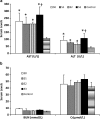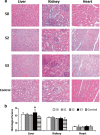The influence of modified pluronic F127 copolymers with higher phase transition temperature on arsenic trioxide-releasing properties and toxicity in a subcutaneous model of rats
- PMID: 22374430
- PMCID: PMC3364388
- DOI: 10.1208/s12249-012-9756-9
The influence of modified pluronic F127 copolymers with higher phase transition temperature on arsenic trioxide-releasing properties and toxicity in a subcutaneous model of rats
Abstract
Pluronic F127 (PF-127) shows thermoreversible property, which is of the utmost interest in optimizing drug formulation and delivery. However, its hitherto unresolved drawback of a low phase transition temperature (T (tr)) has limited its application in injectable drug delivery systems. We have recently synthesized a new type of PF-127 copolymers with higher T (tr) using a simple oxidative method. Here, we have investigated the drug-releasing feature of oxidized PF-127 and oxidized PF-127-containing silver nanoparticles (SNPs), carrying arsenic trioxide (ATO), in a subcutaneous model of rats. Injectable hydrogels prepared with oxidized PF-127s were less viscous and easier to inject, at the same concentration, than their precursor. Addition of SNPs further elevated T (tr), resulting in even lower viscosity of the injectable hydrogel prepared from SNP-containing oxidized PF-127. The oxidized PF-127 copolymers did not differ significantly in ATO-releasing ability, compared with parental PF-127, but the addition of SNPs altered the ATO-releasing feature of oxidized PF-127 to some extent. ATO-carrying oxidized PF-127s had similar toxicity, but the addition of SNPs enhanced the hepatotoxicity of ATO, as evidenced by elevated serum levels of alanine aminotransferase and aspartate aminotransferase and histological alterations, compared to parental PF-127. The results presented herein warrant further investigation of the modified PF-127 copolymers to deliver ATO or other drugs in the form of injectable hydrogels.
Figures




Similar articles
-
Bone-targeting nanoparticle to co-deliver decitabine and arsenic trioxide for effective therapy of myelodysplastic syndrome with low systemic toxicity.J Control Release. 2017 Dec 28;268:92-101. doi: 10.1016/j.jconrel.2017.10.012. Epub 2017 Oct 16. J Control Release. 2017. PMID: 29042320 Free PMC article.
-
A supramolecular host-guest interaction-mediated injectable hydrogel system with enhanced stability and sustained protein release.Acta Biomater. 2021 Sep 1;131:286-301. doi: 10.1016/j.actbio.2021.07.004. Epub 2021 Jul 8. Acta Biomater. 2021. PMID: 34246803
-
pH-triggered sustained release of arsenic trioxide by polyacrylic acid capped mesoporous silica nanoparticles for solid tumor treatment in vitro and in vivo.J Biomater Appl. 2016 Jul;31(1):23-35. doi: 10.1177/0885328216637211. Epub 2016 Apr 7. J Biomater Appl. 2016. PMID: 27059495
-
Acute promyelocytic leukemia: recent advances in therapy and molecular basis of response to arsenic therapies.Curr Opin Hematol. 2005 Jan;12(1):1-6. doi: 10.1097/01.moh.0000148552.93303.45. Curr Opin Hematol. 2005. PMID: 15604884 Review.
-
Arsenic trioxide and acute promyelocytic leukemia: clinical and biological.Curr Top Microbiol Immunol. 2007;313:129-44. doi: 10.1007/978-3-540-34594-7_8. Curr Top Microbiol Immunol. 2007. PMID: 17217042 Review.
Cited by
-
Renin angiotensin system blockage by losartan neutralize hypercholesterolemia-induced inflammatory and oxidative injuries.Redox Rep. 2020 Dec;25(1):51-58. doi: 10.1080/13510002.2020.1763714. Redox Rep. 2020. PMID: 32396454 Free PMC article.
-
A multifunctional targeting probe with dual-mode imaging and photothermal therapy used in vivo.J Nanobiotechnology. 2018 Apr 19;16(1):42. doi: 10.1186/s12951-018-0367-9. J Nanobiotechnology. 2018. PMID: 29673352 Free PMC article.
-
Hyperlipidemia Increases Nalbuphine Brain Accumulation with Multiple Dosing without Affecting Its Analgesic Response-Its Respiratory Depression Potential Should Be Investigated in Future Studies.Pharmaceuticals (Basel). 2024 Feb 22;17(3):282. doi: 10.3390/ph17030282. Pharmaceuticals (Basel). 2024. PMID: 38543067 Free PMC article.
References
-
- Escobar-Chavez JJ, Lopez-Cervantes M, Naik A, Kalia YN, Quintanar-Guerrero D, Ganem-Quintanar A. Applications of therm-reversible pluronic F-127 gels in pharmaceutical formulations. J Pharm Pharmaceut Sci. 2006;9:339–358. - PubMed
-
- Zhang C, Easteal AJ. Milder changes in chemistry make a significant difference in phase transition temperatures for triblock copolymers on PEO106-PPO70-PEO106 block copolymer chains. Macromol Chem Phys. 2008;209:1220–1231. doi: 10.1002/macp.200800040. - DOI
-
- Armstrong JK, Parsonage J, Chowdhry B, Leharne S, Mitchell J, Beezer A, et al. Scanning densitometric and calorimetric studies of poly(ethylene oxide)/poly(propylene oxide)/poly(ethylene oxide) triblock copolymers (poloxamers) in dilute aqueous solution. J Phys Chem. 1993;97:3904–3909. doi: 10.1021/j100117a042. - DOI
Publication types
MeSH terms
Substances
LinkOut - more resources
Full Text Sources

